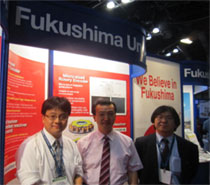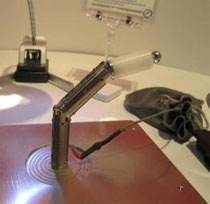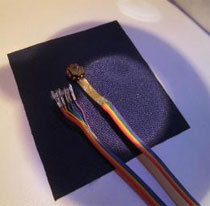Reports and Statistics
Technologies from Fukushima for Developing Medical Devices Attract Worldwide Attention
Interview with Fukushima University Vice President Takahashi, leader of a university research and development team
June 29, 2011
A research and development team led by Fukushima University Vice President Takayuki Takahashi presented state-of-the-art medical equipment technology at an exhibition of Medical Device Manufacturing Technology (MD&M East) held through June 7–9, 2011 in New York City. The university was closed for about two months due to the Great East Japan Earthquake. Research and development were also suspended, and the presentation was temporarily called off. However, they decided to exhibit to show the world that Fukushima is making a powerful comeback. An endoscope and other technologies developed by the team attracted attention, and they had many concrete business discussions with global medical device manufacturers. JETRO New York spoke with Vice President Takahashi on June 9.
We want to show the world our steady comeback
"Using technologies from Fukushima Prefecture for developing medical devices, we want to show the world that our prefecture is making a steady comeback," said Fukushima University Vice President Takayuki Takahashi. He presented new technology that can be used in advanced endoscopes and other equipment at an exhibition of medical device manufacturing technology held in New York City. This new technology was developed over the past two years in cooperation with local small- and mid-sized businesses. The Great East Japan Earthquake occurred just as they were making the final adjustments in preparation for exhibiting the technology. On top of that, the university was essentially closed for about two months due to the nuclear power plant problems, and research and development were also stopped. Dr. Takahashi said that the impact of the earthquake was great, and he thought for a while of cancelling the exhibit at MD&M East. In the midst of this, countries and regions around the world, especially the US, have been very supportive, and he witnessed that support in Fukushima. "We cannot quit now. We are so thankful for the support of people around the world, and now especially, we want to show that Fukushima can make a comeback. With this in mind, we decided to take part in the exhibition," he said.

Fukushima University Vice President Takahashi (center), leader of the university research and development team
Associate Professor Sasaki of Tsuruoka National College of Technology (left), Professor Yamaguchi of Fukushima University (right)

Prototype of 13-mm diameter endoscope

The world's thinnest angle sensor, at 3 mm thick
Prototyping an endoscope that combines the new technologies
The Fukushima University research and development team played a central role in developing a zero-backlash 3D cam with a large range of motion in various directions (international patent pending), a small, zero-backlash reducer with high transmission ability (international patent pending), and the world's thinnest angle sensor (patented in Japan).
To develop the 3D cam and reducer, the team collaborated with Namiki Precision Jewel Co., Ltd. (Tokyo), a manufacturer of industrial jewel parts; Atom Corporation (Bandai-machi), a local Fukushima precision machining parts manufacturer; and Associate Professor Hiroyuki Sasaki of Tsuruoka National College of Technology. The team developed the angle sensor in cooperation with Matsuo Industries, Inc. (Obu City, Aichi Prefecture). In addition, Professor Katsuhiko Yamaguchi of Fukushima University is leading the development of a waterproof angle sensor. Although each technology on its own is a breakthrough that can be applied in fields such as the aerospace and robotics industries, the team has combined the technologies into a prototype endoscope with a diameter of 13 mm, the size generally used in surgery, which they exhibited at MD&M East.
Dr. Takahashi said, "The endoscopes currently used in surgery generally have few degrees of freedom, so treating the opposite sides of internal organs is difficult. In addition, because of the error and backlash caused by the bending parts of endoscopes, they are difficult to operate with precision. Our new technology has overcome these two problems."
Research and development continues toward miniaturization
The endoscope that was exhibited is a prototype, but Dr. Takahashi said, "We want to commercialize it this year as a 13-mm endoscope. Two to three years after that, we aim to shrink the diameter from 13 to 5 mm and to decrease the endoscope bending space (the length from joint to joint) to 30 mm." The key to this is downsizing the gears, 3D cam, sensors, motors, and other major parts. If this can be done, it will greatly increase the usefulness of this medical device for surgery. Dr. Takahashi explained, "We are currently working with companies to develop the major components."

Prototype of 5-mm diameter endoscope, which is under development
High-quality technology is noticed, leading to many concrete business discussions
Looking back on the exhibition, Dr. Takahashi found that it was very productive, despite the difficulty in the timing. One of the results was many concrete business discussions with global medical equipment and precision equipment manufacturers about the prototype endoscope and angle sensor. Dr. Takahashi said that the concrete example of a product led to the concrete discussions with the manufacturers. He said that he would like to turn the university's technology into products that can actually be used by building communication with those companies.
Another result was showing the world that Fukushima is making a steady comeback. "Many exhibition attendees were rooting for us. Expressing our gratitude to each of them for their great support as well as being able to convey the message that we are working hard and making steady progress toward a comeback was an important result," he said.
As the Fukushima University research and development team works with corporations to develop the technology into useful products, the world is taking note of the technology from Fukushima for developing medical devices.



